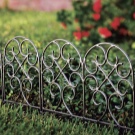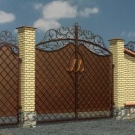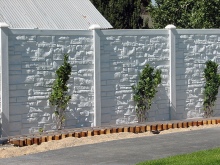All About Garden Fences

Garden fences and fences are an integral part of the design of the suburban area. Depending on the type, material and location in the country, they can perform both a decorative and a protective or supporting role. Let's talk about garden fences.



Description of species
First of all, fences are divided by functionality and technical parameters into external and internal.
External
The main purpose of external fences is to protect the perimeter of the site from uninvited guests, for example, wild animals. The fence also serves to mark the boundaries of a private area, protects from prying eyes.



Internal
Inside the site, fences are designed to perform a number of functions.
- Space zoning.
- Protection of beds and flower beds from domestic animals, dogs, small children.
- Separation of landings. Preventing the spread of weeds. Curbs can be buried in the soil, preventing the growth of the root system outside the designated area.
- Support for shoots, climbing plants, shrubs. Heavy branches will require a fence made of durable materials.
- Giving a finished look to the landscape design of the site.
- Track decoration.





Materials and design
Fences and fences are now available in a wide variety of materials. The most popular hedges are made of metal, wood, concrete, plastic and stone.

Metal
Today, metal fences are extremely diverse. These are solid fences with an impressive height and low openwork borders.
Usually such fences are made to order by special firms. Forged, cast, and welded fences are popular, profiled sheet and metal mesh are often used.
A wrought-iron fence is an example of reliable protection, it is almost eternal. It also looks great from an aesthetic point of view. Fences are in perfect harmony with buildings in various styles. The strength of the structure stems from the complexity of the design sketch - the more it is saturated with patterns, the stronger the fence. In addition, it is almost impossible to see 2 absolutely identical forged fences. Moreover, the only significant drawback of this option is the high price.






Cast fences will be appropriate in large adjoining areas with a multi-storey cottage or a monumental and lush mansion in the center. For flower beds and gardens, low cast fences with a minimum number of decorative elements are used. Such curbs, fences, fences will last quite a long time, more than 50 years. Accordingly, their cost is quite high.


Conventional fences made of profiled sheet usually do not differ in aesthetics. To improve the appearance, the metal profile is combined with other building materials. Structures stylized as a hedge made of stone, wood, brick are produced. In any art studio, it is possible to order a painting of a fence according to a sketch - a landscape, animals, abstract patterns and more. The so-called European picket fence is made from the profiled sheet. It allows air and light to pass through, which has a beneficial effect on the soil. The pointed top protects against intruders. The professional sheet is durable, does not rust.



Welded gratings. For their manufacture, iron rods with a cross section of a circle or square are used. The sections can be attached with a solid canvas or at a distance, creating free air circulation. They do not require careful maintenance, although the joints of the rods are prone to corrosion. Unlike a sheet fence, such a fence is more affordable.


3D fence. The modern version of the fence made of welded mesh panels is installed along the perimeter of the territory. Thin and lightweight, it will not create difficulties during installation, and its laconic appearance does not burden the landscape design of the site.


The netting-netting is the most budget material for the fence. The main thing is that the soil allows you to install the support pillars with the help of butting. Installation of the mesh is simple. A chain-link mesh of various types is considered resistant to corrosion: galvanized, painted white or any other color, as well as covered with a polymer layer. The last option looks the most attractive aesthetically. A fence made of a chain-link mesh is decorated with climbing plants - they, growing up, weave their branches into cells.



Brick
I often use brick for the construction of fences - it is durable and reliable, which attracts users. With the correct implementation of the brickwork technology, a brick fence can last a long time.
It does not require special care, it is resistant to the vagaries of the weather, temperature extremes.
Classic fences are built from bricks of various types: silicate, ceramic, as well as hyper-pressed and clinker types. A variety of intricate masonry is used, often brick and art forging are combined in the fence, as well as patterned decorative concrete elements, wooden parts.






Stone
A stone fence has the same performance characteristics as a brick fence. but buildings made of stone, both natural and artificial, attract with their picturesque structure, as a rule, have a presentable appearance. Individual stones, as a rule, differ in their shape and size. Therefore, stone fences look so interesting. They can be created from various elements, such as polished stone blocks, large specimens of colored pebbles, torn and hewn stones. Everything is limited only by the imagination of the owner of the site.



Concrete
As a rule, concrete fences are made to delimit two adjacent areas. Monolithic concrete slabs are installed in the grooves on the support pillars. In the manufacture of these slabs, pigments are added to the concrete mixture in order to give the surface a shade, or to imitate any natural material, wood, metal, stone.
Concrete slabs are produced with a convex image, including transparent decorative segments.
Concrete fences are very durable, strong and reliable, they are not afraid of precipitation, temperature changes, corrosion or decay. The only drawbacks are the high cost and rather laborious installation work. There are beautiful concrete fences of a smaller form - these are decorative fences for flower beds and flower beds. They come in a variety of colors and patterns.



Plastic
The main advantage of decorative plastic fences is the variety of shapes and colors. One of the popular applications is picket sections. They can be completely different in design. The most in demand are models that imitate a tree, with which you can fence a front garden.

Plastic is also used to make tape fences. The flexible design of such fences allows you to go around a garden bed or flower bed of any shape. Convenient and installation - the tape is easy to cut with a secateurs and connect with a stapler. They are attached to the soil with special wooden stakes and reinforcement rods.

The corrugated version of the tape has the most attractive appearance. Such a fence is very durable - it withstands cold up to -30 degrees, is not afraid of ultraviolet radiation and moisture. Due to the quite budgetary price, it is widespread in hardware stores and gardening stores.


Wood
A wooden fence is, of course, a classic, the oldest version of fencing that fits perfectly into the landscape of a country-style site. Despite the fact that the tree does not freeze and does not heat up, the life of the fence is rather short. However, this can be corrected by applying special compounds to the material. For protection, a wooden fence is painted or coated with special compounds.

Both fences and curbs made of wood have many variations.
- The most common fences are made of hewn boards, and they can be either flat or pointed. You can nail them vertically, as well as horizontally, overlapping \
- Decorative picket fence with carving.
- From thin wooden slats, you can create a lattice with diamond-shaped gaps. They can be used for climbing plants.
- Flowerbed borders.
- Products from simple branches. They are carefully selected. It is imperative to use wood processing products.
- Palisade - a similar fence can be made from a row of logs dug or driven into the ground vertically close to each other.
Wooden fences are the closest plant structures. The advantages of wooden fences include ease of installation and low cost of materials.




Other
A rather rare type of fencing in Russia is gabions. They are a frame made of thick wire mesh, filled with various decorative items inside. It can be natural stone, gravel or pebbles, sometimes brick, wood, and other materials are used. Gabion can be of any height, often serves as an external fence, but you can make a low curb inside the garden.
The shape of the structure of such an original fence can be very different, and you can decorate it with plants.
So, among the stones, containers filled with earth are built in, where those crops are planted for which such conditions will be suitable. Competently arranged gabions, in harmony with the surrounding nature, will successfully complement and decorate the landscape.


One of the traditional types of rural fences is a wicker or wattle wicker twisted from willow branches, birch canvases, often they are spruce. The length of flexible branches is taken from about 50-70 mm. Before weaving, the material is soaked for a day. Trellises for loaches are also made of vines. To give the hedge a more interesting look, you can add flowers, figurines of birds, animals, clay utensils, pots, bowls and much more to the decor. A skillfully twisted and properly made wattle fence can last almost as long as a wooden fence.



Willows planted in a row around the perimeter of the site can also be turned into a fence by weaving their long shoots together. Many varieties of dwarf willow are used as hedges. The trees planted at a distance of 1 meter from each other, growing up, form a whole living green wall.

Polymer sand fencing is made from environmentally friendly polyethylene, dyes and sand. Such fences are durable, shock-resistant, resistant to aggressive environments, and do not absorb moisture. Convenient and easy to install in the soil. They are intended primarily for edging flowering rectangular and radial flower beds.

For the manufacture of fences on the site, materials at hand are often used. Craftsmen make mini-garden fences from plastic containers. So, bottles of one certain volume are deepened with their necks down into the soil along the perimeter of the garden bed or flower bed. For beauty, they can be filled, for example, with pebbles, colored glass balls.


Thin and flexible rods, both wooden and metal, can be bent and stuck into the ground around the beds, forming arches. The result is an elegant design that does not take up much space, resembling a wave. You can also use old tires, polycarbonate, and more.

Installation tips
Installation of capital external fences made of concrete or metal is a rather laborious task, for this it is recommended to involve specialists and even construction equipment. The construction of a brick fence for a better result requires adherence to masonry technology. Quite simply and affordable for everyone, you can install decorative fences made of plastic structures.You need to start by securing the anchors or supporting posts, then you need to join the sections. After installing each of them, it is important to monitor the observance of the angle of inclination and compliance with the markings; this will require a tape measure and a level.
How to make a decorative fence with your own hands from pallets, see the video.













The comment was sent successfully.